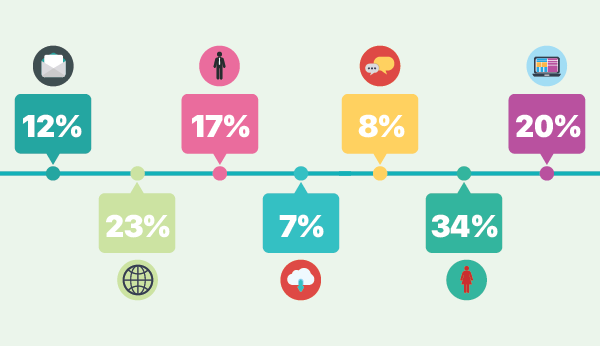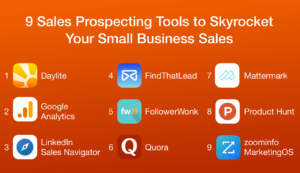Want your small business to bring in more money? Of course you do! To help you do that, here are five things you can track and start leveraging to increase your sales.
Lead Source
Where are your leads coming from? Lead sourcing is about tracking down where your leads are coming from so you can ramp up what’s working, and stop or tweak what’s not working.
Tracking your lead sources doesn’t have to involve expensive marketing activities either. You can capture lead source simply by asking each lead how they heard about you. This can be done on a call, in a meeting, or automated through a client intake form on your website.
By tracking your lead source, you can identify what gives you the best leads, or the best chance of converting leads into clients.
For example, you may find that you get the least amount of leads from referrals, but that the leads that come from a referral have the highest chance of converting. If this is the case, you’ll want to focus on driving more referrals by touching base with clients to ask for referrals or creating a referral program.
To identify these areas of opportunity, you’ll want to track your lead sources and then start compiling and analyzing the data to look for trends. This can be done through a spreadsheet at minimum, but ideally through a small business CRM, like Daylite for example.
Daylite Tip: If you’re using Daylite as your CRM, check out this tutorial on How To Track Your Lead Source.
Conversion Rates:
What percentage of deals do you close on average? Conversion rates, (or closing ratios) are the number of deals you close versus the amount of pitches you make. Say you sent out ten proposals last week, and three of them converted into paying clients. Then your ratio would be 3:10 in terms of proposals to closures.
Tracking these conversion rates over time allows you to track your performance and identify where there’s opportunity for growth. The average company closes between twenty to thirty percent of their sales pitches. A small increase in close rate can have a huge knock on effect on your bottom line. Rather than trying to get more deals in the pipeline, try to identify what you can do to close more of the deals you already have.
For example, following up more, following up faster, or improving your negotiation techniques are all things that can help you increase your close rate and therefore increase sales – all without having to drive more leads.
You can track your leads and closes to calculate your close rate in a spreadsheet at minimum, or by using a small business CRM like Daylite for example, for easier reporting.
Daylite Tip: If you’re using Daylite as your CRM, check out this tutorial How To Track Your Close Rate.
Deal Size
How much is each deal worth in dollars? Deal sizes are an interesting subject in that they are ripe with opportunity in several different ways. Say you want to attract deals with the largest return on investment. By tracking what type of deals you’re making, and the size of the projects compared to ROI, you can create an idea of what to pursue.
For example, if you’re a real estate agent with many leads on the go, focusing on the higher selling properties leads to a better ROI because of the nature of commission sales. This can feel overwhelming due to how many deals and clients you’re juggling at once. Through tracking the deal size, you can prioritize which deals you focus on so you can increase sales.
Daylite Tip: To capture and track how much each deal is worth and sort all your deals by value, check out this Daylite tutorial.
Deals in the Pipeline
How many leads are coming down the pipe for future sales? This is integral to any small business and in definite need of tracking. If we’re going with the average conversion rate listed above of 20-30%, a small business should have at least three times the amount of leads as you need clients to reach your sales quota.
By tracking your lead numbers, along with your close rate, average sales price and monthly revenue targets, you should be able to come up with a number of leads that you need coming in at any given time, depending on your product or service offerings.
Track how many deals you have each month coming in so you can make sure you have business for the future. Set a threshold that if you have less than X leads or X value in potential deals coming in this month, it’s a red flag that you need to start drumming up more business. This will help you avoid having cashflow problems ahead and make sure you’re being proactive about increasing sales for steady growth.
Daylite Tip: Using Daylite Opportunities you can track each deal and sort how many deals you have in the pipeline and what stage each one is in. For more info, check out this Daylite tutorial. If you want a visual report of how many deals are in each pipeline stage, check out this Daylite Sales Funnel Report from LgoKnowledge.
Why You’re Winning and Losing Deals
Do you know why you’re losing deals? Do you have data to prove it? Don’t guess. Use data. By tracking why you’re losing deals and why you’re winning others, you can identify what’s working and what needs improving.
For example, you may find that you’re not quick enough to follow up and you’re letting the competition swoop in. You may find your prices need to be adjusted to meet the needs of your buyers. Or you may find that there’s a specific service or product offering that your competitors has that you don’t.
All of these reasons are things you can leverage and strategically choose what to change.
It may sounds obvious and maybe even a little uncomfortable, but to do this you need to ask. Ask every client you just won over why they chose to go with you. And ask every lead you don’t close why they chose not to. You don’t have to be aggressive about asking, just curious so you can identify where your business needs improving.
Capture the reason you lose and won a deal for as many deals as you can to get more data. Once you have this data, you can start compiling and analyzing, looking for areas of opportunity .
You can capture this data in a spreadsheet and then separate the deals you’ve won vs the ones you lost to identify trends. Or you can capture and analyze this information in a small business CRM like Daylite for example. To do this in Daylite, you’ll want to capture Opportunity won/loss reason and then report on this data. To learn how, check out this help article.
Once you’ve figured out your strengths and weaknesses, make sure to push your strengths further through marketing so you can ramp up more leads and increase sales. And for your weaknesses, you may strategically choose to not work on those, or there may be things you can work on that make sense to your overall business strategy.
Daylite Tip: If you’re using Daylite as your CRM, here’s how you can track the reasons you’re winning or losing business.
Conclusion
Increasing sales for your business isn’t always just about getting more leads. There are many factors that contribute to the success of sales in the small business world. By tracking your lead source, conversion rate, deal size, number of deals in the pipeline, and why you’re winning or losing deals, you’ll have plenty of levers to pull so you can start ramping up sales for your small business. By putting in the work to track and analyze this data, you’ll identify many areas of opportunity to optimize your sales funnel.



